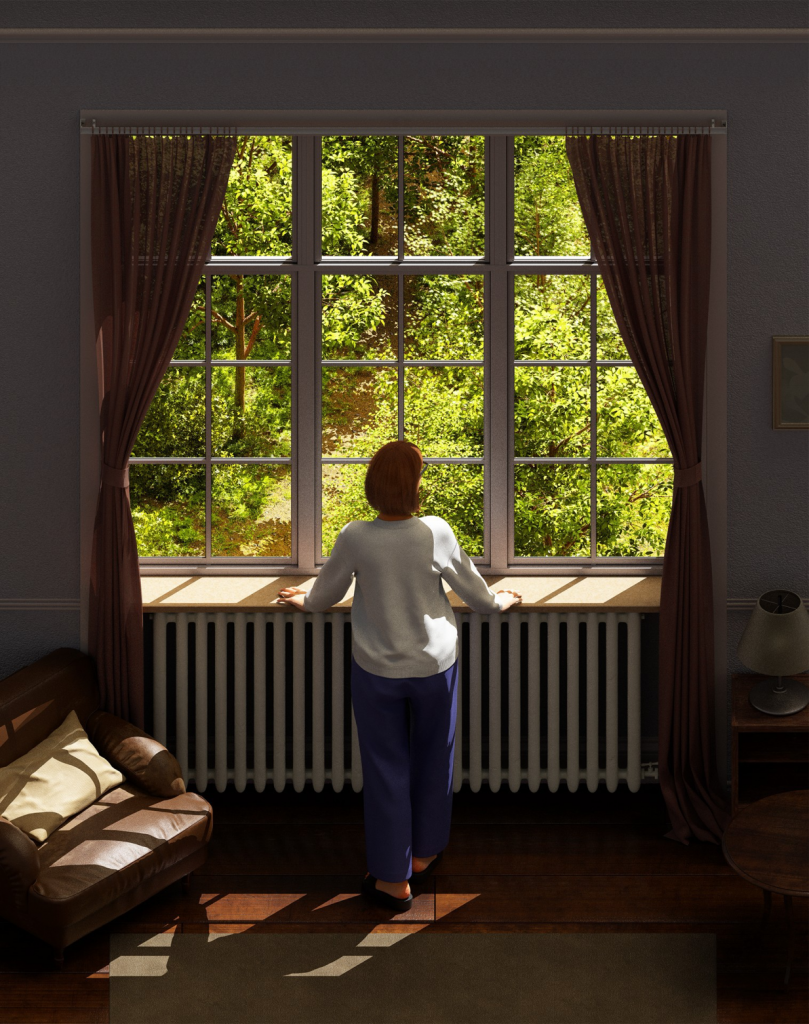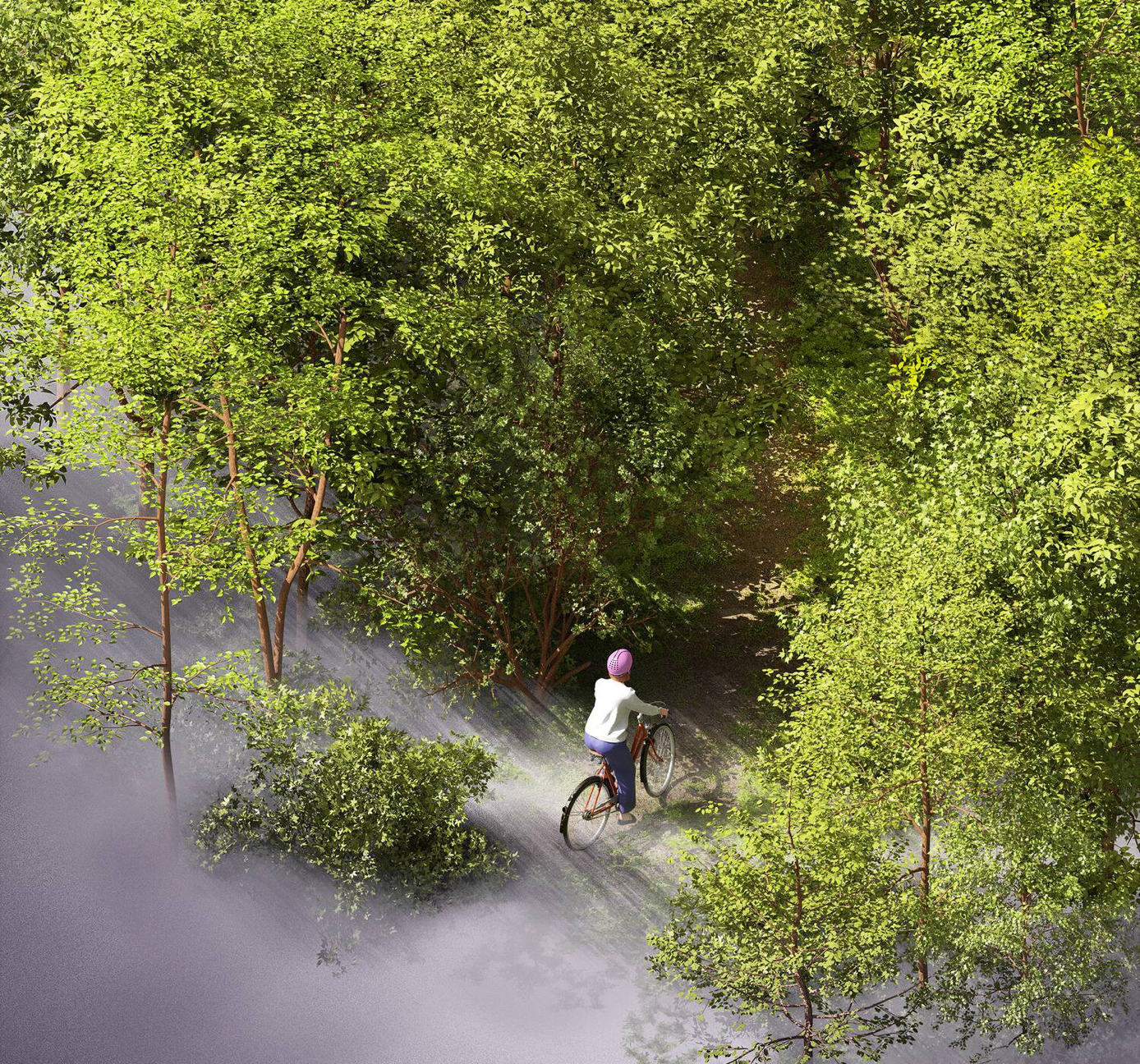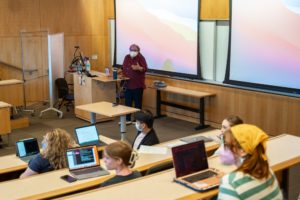It’s April and gorgeous out, but I am too depressed to get out of bed. I feel like I’m stuck in some viscous fluid and the only sensible thing to do is just go back to sleep. I’m occasionally woken up by the sound of my husband on back-to-back conference calls. Is it really necessary to yell? I wonder. But I can’t complain, since he’s working hard while I’m … not.
It’s late afternoon when Steve finally notices that I’m still in bed. “Are you okay?” he says.
“When did bedpans go out of style?” I say, avoiding the question. “I bet if Anthropologie started selling them, they’d be a hit.”
“You need to get outside,” Steve says.
The outdoors is the last place I want to be right now. Just taking the elevator is rife with peril, especially when only half of the people in our building seem to be wearing masks. I live in Navy Yard, a densely populated neighborhood south of Capitol Hill in Washington, and the sidewalks are crowded with people who are constantly wandering into my six feet of airspace. It’s stressful trying to calculate dozens of other people’s trajectories and intentions.
I can’t help but wonder if Steve just wants me out of the apartment. We’ve been living and working in the same 720 square feet for more than a month. It’s quite a change from our pre-pandemic lives. Steve’s job had him trotting the globe for weeks at a time, and I was always out and about — writing from coffee shops and then flitting from museums to concerts to restaurants.
I decide to take his advice, though, because I do need some exercise. I find my squeaky old bike and set off toward the Mall. Then I remember that I’m trying to avoid people, so I circle the block and head in the opposite direction, away from the crowded center of the city and alongside the Anacostia River, all the way to its headwaters in Bladensburg, Md.
On my way back home I am feeling better. Getting my heart rate up definitely helps, but even more uplifting is the hopeful spring landscape: lime green fields freckled with wildflowers, trees unfurling new leaves, ducklings splashing in a mud puddle.
I crest a hill, and something panics in the tall grass. A deer! He’s trapped between me and a chain-link fence, and when he leaps forward I instinctively speed up. We race side-by-side down the hill; the fence comes closer to the bike path, pushing the buck toward me. I want so badly to touch him, or, even better, to follow him into a world that makes a lot more sense than mine does right now.
But the ground flies up at my face, and suddenly I’m beside the path with my bike half on top of me. It appears that I’ve skidded out on a patch of dry leaves. My pants are torn and my knees are bleeding, but I’m basically fine. The deer is long gone.
Sitting dazed on the pavement, I wonder what kind of madness has gotten into me. The pandemic and accompanying shutdowns are affecting everyone, of course, and I truly have nothing to complain about when other people have lost jobs or loved ones. But as an extreme extrovert suddenly forced into near-total isolation, I feel like a dried-out husk of my formerly vivacious, gregarious self. Am I so desperate for company that I’ve taken to chasing down wild animals?
In fact, I’m about to go through a profound change. As the pandemic drags on, my need to connect with nature intensifies to the point where I don’t even want to sleep indoors. I spend entire days in city parks and come home with twigs in my hair, claiming to have learned the language of birds. I become so attached to nature that I barely even recognize myself.

As it turns out, the stress of 2020 has many of us looking for relief among the leaves. National and state parks, especially those near population centers, are seeing lots of foot traffic: Year-to-date visitorship as of October was up 14 percent at Shenandoah National Park, 16 percent at Amistad National Recreation Area and 55 percent at Catoctin Mountain Park. People also seem to be engaging with nature more deeply than before the pandemic. As of mid-December, iNaturalist, an app that citizen-scientists use to identify wild plants and animals, had seen a 62 percent jump in users and a 60 percent increase in observations in 2020 as compared with 2019.
A similar shift happened during the last major pandemic, says historian Terence Young, author of “Heading Out: A History of American Camping.” Being outdoors was considered (correctly) to be healthier than the indoors, and that seeded a surge of car-based camping. “In 1918, many people took up car camping because they were afraid of traveling to campgrounds on trains, which was the main way people got to national parks back then,” Young says. “Then the popularity of car camping really exploded after the pandemic, in the 1920s. I think we’re going to see that happen again, but with RVs this time.” (Indeed, RV shipments to dealers have jumped 4 percent this year and are expected to increase by 19 percent in 2021.)
After the 1918 flu pandemic, though, so many people visited national parks that it took a noticeable toll on the beauty of America’s most stunning landscapes. Young worries that might happen again if maintenance budgets don’t keep up. “I want people to go out to the natural world because then they will want to protect it,” he says. “But they need to understand that there is a price.”
The surge of interest in the outdoors since the pandemic took hold isn’t specific to America. One study published in November in the Journal of Forestry Research analyzed Google location-tracking data and found significant increases in park usage worldwide during the pandemic’s first wave.
The recent bump of interest in outdoor hobbies such as gardening and hiking “could be one of the silver linings of the pandemic,” says Selin Kesebir, associate professor of organizational behavior at London Business School. “Even if they don’t continue with them after the pandemic, we know that being outdoors is a very good way of coping with the current situation.”
Research has been piling up since the 1970s on the many salutary effects of spending time in nature. A walk in the park, or even just looking out a window at some trees, decreases blood pressure, stress hormones and symptoms of anxiety and depression. Exposure to natural settings also spurs improvements in mood, cognitive function, and empathy and cooperation.
How green places work this magic is a bit of a mystery, but, according to a paper published this year in the journal Cognitive Research: Principles and Implications, it seems that natural settings give us exactly the right amount of stimulation. A babbling brook, a Creamsicle sunset, the smell of wet ground after rain — these phenomena capture our interest, but they don’t require the focused attention demanded by most indoor activities, such as doom scrolling or watching “The Great British Baking Show.” Being in nature seems to give the brain permission to relax and just exist. “Something about nature helps us to stay more mindful and improves our executive function,” Kesebir says.
This certainly fits with my experience. I’ve always found it relaxing and rejuvenating to be outdoors, but the anxiety and isolation of the pandemic, the uncertainty of civil unrest and, oh, I don’t know, the potential crumbling of American democracy have made me crave nature like a drug.
A walk in the park, or even just looking out a window at some trees, decreases blood pressure, stress hormones and symptoms of anxiety and depression.
About a week after chasing the deer, I’m sitting on the ground with my back pressed against the scaly bark of an American elm. I look around to make sure no one’s watching, then lie sideways on the dirt, with my ear to the ground. I’ve been desperate for sensory stimulation since the movie theaters and museums closed, so when a nature book tells me that a wonderland of exotic smells and sounds awaits anyone bold enough to get their head close to the ground, I decide to give it a try.
The book, “What the Robin Knows: How Birds Reveal the Secrets of the Natural World,” by Jon Young, explains that songbirds are the surveillance system of any forest. They work together to keep an eye out for danger, and if you spend a great deal of time just sitting quietly in one spot, you can learn to decipher their calls. I’ve chosen a wooded city park on the Anacostia called Heritage Island as my “sit spot,” but a few days in I’m feeling a little discouraged. I already know the songs of common birds, but I still have no idea what their quiet little chips and chirps could possibly mean.




